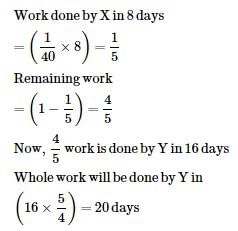Test: Quantitative Techniques- 2 - CLAT MCQ
20 Questions MCQ Test CLAT Mock Test Series 2025 - Test: Quantitative Techniques- 2
In a class average age of 24 boys and their teacher is 15 years. When the teacher's age is excluded the average age decreases by one year. The age of the teacher is?
The monthly income of P and Q are in ratio 2:3 and their monthly expenses are in ratio 5:9. If each of them save 300 per month, their monthly income is:
| 1 Crore+ students have signed up on EduRev. Have you? Download the App |
Man covers a certain distance by driving a car at the speed of 60 km/h and return back to the starting point at the speed of 40 km/h. Find its average speed?
Two numbers are such that the ratio between them is 3:4 but if each is increased by 3 then the ratio becomes 4:5. Find the difference between the numbers?
At present, the age of the father is five times that the age of the son. Three years hence, the father's age would be four times that of his son. Find the present age of the father and the son?
If 25% of a number is 65, then 45% of the number will be?
A and B have money in the ratio 2:1. If A gives Rs. 2 to B, the money will be in the ratio 1:1. What were the initial amounts they had?
18 men can reap a field in 50 days. In how many days will 30 men can complete the same work?
A is working and B is sleeping partner in a firm. A invest Rs 2100 and B invests Rs 3100. A being working partner gets 25% of the profits, and the balance of the profits to be divided in the proportion to their capitals. What did each get out of profit of Rs 1040?
A man has some hens and cows. If the number of heads be 48 and the number of feet equals 140, then the number of hens will be:
If a man can row at the rate of 5kmph instill water and his rate against current is 3.5kmph, then man's rate of speed along current is?
If a square field has its area equal to 324m2 then the perimeter of the field?
X alone can complete a piece of work in 40 days. He worked for 8 days and left. Y alone complete the remaining work in 16 days. How long would X and Y together take to complete the work?
The difference between simple interest and compound interest on certain sum of money for 2 years 4% per annum is Rs 1. Find the sum?
By selling a bicycle for Rs. 2,850, a shopkeeper gains 14%. If the profit is reduced to 8%, then the selling price will be:
A men went to RBI with Rs 2000. He asked the cashier to give him Rs 10 and Rs 20 notes only in return. The man got 150 notes in all. How many Rs 10 notes did he get in all?
If price of a book is first decreased by 25% and then increased by 20% the net percentage change in the price of the book will be
A dice is rolled twice. What is probability of getting the sum 5?
Three numbers are in the ratio 1 : 2 : 3 and their H.C.F is 12. The numbers are
|
1 videos|10 docs|63 tests
|
|
1 videos|10 docs|63 tests
|

























